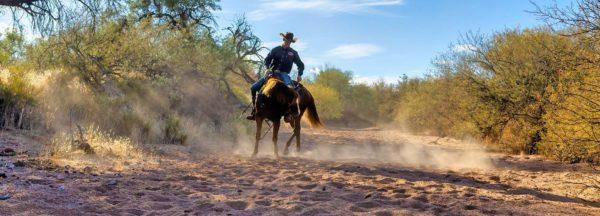Training Tip: Horse is Sour About Spurs

Question: My 4-year-old gelding is just starting to learn Bending at the Walk. He knows all the Fundamentals groundwork and half of the Intermediate groundwork exercises. The first few times he was ridden with spurs, he was a tad cranky, but he suppled and bent his ribs nicely. The fourth day of working with spurs, he bent his ribs and went forward and around nicely. However, when asked to go forward to do some Cruising, he pinned his ears and ran backwards. All I did was press very lightly with the spurs. Usually, he loves to go forward and is respectful of just a bare heel. How can I prevent “spur sourness?” – Rose K.
Answer: It sounds like you’ve done a great job following the Method and training your horse up to this point. In the Method, we typically introduce spurs to our horses when we reach the Fundamentals exercise Bending at the Walk. The reason why we introduce spurs when beginning suppling exercises is because often during these exercises horses have a tendency to lean on your leg and ignore you. That’s where using spurs as reinforcement for your leg cues is important. It teaches the horse that if he chooses to ignore you, there will be a direct consequence.
Spurs are nothing more than an extension of your leg, just as the Handy Stick is an extension of your arm when you’re doing groundwork. Something to keep in mind is that spurs are only to be used to move the horse’s five body parts and to soften and supple his body. They should never be used to get a horse to speed up. How you cue your horse to move forward or speed up should not have changed because you have spurs on. You still want to ask him to move forward by gently pressing his sides with the calves of your legs. If he ignores you, then cluck to him, “cluck, cluck.” If he still ignored you, you’d spank him with the end of your reins or dressage whip. But you wouldn’t use your spurs to make him go forward.
Wearing spurs is a little bit of a learning curve for riders, as you have to make sure you’re not accidently poking the horse with them. You have to be conscious to keep your heels down so that the spurs stay off his sides.
With all that being said, if a horse develops a cranky attitude about spurs, no matter the reason, it’s unacceptable. I stop what I’m doing and bend him in a circle, keeping my spur on his side until he relaxes and stops pitching a fit. As long as you have the horse’s head bent to the side, he can’t go anywhere but around in a circle. If his head is straight, he could take off, buck or rear.
Looking for more training tips? Check out the No Worries Club. Have a training question? Send it to us at [email protected].
